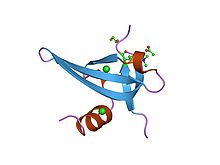Chromodomain
| Chromodomain | |||||||||
|---|---|---|---|---|---|---|---|---|---|

Structure of polycomb chromodomain.
|
|||||||||
| Identifiers | |||||||||
| Symbol | Chromodomain | ||||||||
| Pfam | PF00385 | ||||||||
| InterPro | IPR000953 | ||||||||
| SMART | SM00298 | ||||||||
| PROSITE | PS50013 | ||||||||
| SCOP | 1pfb | ||||||||
| SUPERFAMILY | 1pfb | ||||||||
| CDD | cd00024 | ||||||||
|
|||||||||
| Available protein structures: | |
|---|---|
| Pfam | structures |
| PDB | RCSB PDB; PDBe; PDBj |
| PDBsum | structure summary |
A chromodomain (chromatin organization modifier ) is a protein structural domain of about 40-50 amino acid residues commonly found in proteins associated with the remodeling and manipulation of chromatin. The domain is highly conserved among both plants and animals, and is represented in a large number of different proteins in many genomes, such as that of the mouse. Some chromodomain-containing genes have multiple alternative splicing isoforms that omit the chromodomain entirely. In mammals, chromodomain-containing proteins are responsible for aspects of gene regulation related to chromatin remodeling and formation of heterochromatin regions. Chromodomain-containing proteins also bind methylated histones and appear in the RNA-induced transcriptional silencing complex.
...
Wikipedia
